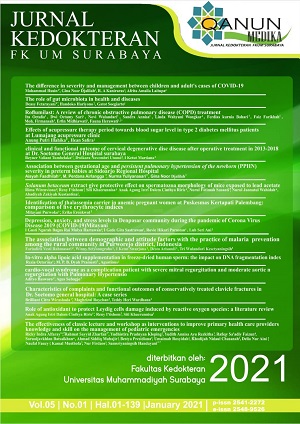Identification of Thalassemia Carrier in Anemic Pregnant Women at Puskesmas Kertapati Palembang: Comparison of Five Erythrocyte Indices
Abstract
Full text article
References
Amini A. (2018). Umur ibu dan paritas sebagai faktor risiko yang mempengaruhi kejadian anemia pada ibu hamil di wilayah kerja Puskesmas Ampenan. Midwifery Journal, 3(2):108-113.
Anchang-Kimbi JK, et al. (2017). Profile of red blood cell morphologies and causes of anaemia among pregnant women at first clinic visit in the mount Cameroon area: a prospective cross sectional study. BMC Research Notes, 10(645).
Angastinioti M & Lobitz S. (2019). Thalassemia: An overview. International Journal of Neonatal Screening, 5(16):1-11.
Astriana W. (2017). Kejadian anemia pada ibu hamil ditinjau dari paritas dan usia. Jurnal Aisyah: Jurnal Ilmu Kesehatan, 2(2):123-130.
Astuti D & Kulsum U. (2018). Pola makan dan umur kehamilan trimester iii dengan anemia pada ibu hamil. Indonesia Jurnal Kebidanan, 2(1):24-30.
Bakrim S, et al. (2018). Hematological parameters of the blood count in a healthy population of pregnant women in the Northwest of Morocco (Tetouan-M’diq-Fnideq provinces). Pan African Medical Journal, 29(205).
Hapsari AT & Rujito L. (2015). Diagnostic test of blood index and molecular identification of ï¢ Thalassemia carrier among blood donor subjects in Banyumas. Jurnal Kedokteran Brawijaya, 28(3):233-237.
Jahangiri M, Rahim F, & Malehi AS. (2019). Diagnostic performance of hematological discrimination indices to discriminate between βeta thalassemia trait and iron deficiency anemia and using cluster analysis: Introducing two new indices tested in Iranian population. Scientific reports, 9(1):18610.
K Alene A & A Dohe M. (2014). Prevalence of anemia and associated factors among pregnant women in an urban area of Eastern Ethiopia. Anemia, 561567.
Li A et al. (2017). Establishment of reference intervals for complete blood count parameters during normal pregnancy in Beijing. J Clin Lab Anal, 31:22150.
Öztürk M et al. (2017). Anemia prevalence at the time of pregnancy detection. Turk Jinekoloji ve Obstetrik Dernegi Dergisi, 14(3): 176–180
Paendong FT, Suparman E, & Tendean HMM. (2016). Profil zat besi (Fe) pada ibu hamil dengan anemia di Puskesmas Bahu Manado. E-Clinic, 4(1):369-374.
Parikh R et al. (2008). Understanding and using sensitivity, specificity and predictive values. Indian Journal of Ophthalmology, 56(1):45-50.
Patel AJ et al. 2013. Capillary versus Venous Hemoglobin Determination in the Assessment of Healthy Blood Donors. HHS Journal, 104(4): 317-323.
Prakash S, and Khushbu Y. 2015. Maternal Anemia in Pregnancy: An Overview. International Journal of Pharmacy and Pharmaceutical Research, 4(3): 164-179.
Shagana JA et al. (2018). Physiological changes in pregnancy. Drug Invention Today, 10(8):1594-1597.
Srour MA et al. (2018). Prevalence of anemia and iron deficiency among Palestinian pregnant women and its association with pregnancy outcome. Anemia, 9135625.
Stephen G et al. (2018). Anaemia in pregnancy: prevalence, risk factors, and adverse perinatal outcomes in Northern Tanzania. Anemia, 1846280.
Suega K et al. (2002). Iron-deficiency anemia in pregnant women in Bali, Indonesia: A profile of risk factors and epidemiology. Southeast Asian Journal of Tropical Medicine and Public Health, 33(3):604–607.
Sukrat B et al. (2010). The prevalence of iron deficiency anemia in pregnant women in Nakhonsawan, Thailand. Journal of the Medical Association of Thailand, 93(7):765–770.
Suryanarayana R et al. (2017). Prospective study on prevalence of anemia of pregnant women and its outcome: A community-based study. Journal of Family Medicine and Primary Care, 6(4):739.
Viprakasit V & Ekwattanakit S. (2018). Clinical classification, screening and diagnosis for Thalassemia. Hematology/Oncology Clinics of North America, 32(2):193-211.
Zanella S, Garani MC, & Borgna-Pignatti C. (2016). Malignancies and Thalassemia: a review of the literature. Annals of The New York Academy of Sciences, 1368(1):140-148.
Authors

Qanun Medika by FK UM Surabaya is liscence under Lisensi Creative Commons Atribusi 4.0 Internasional.

